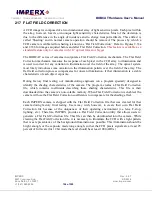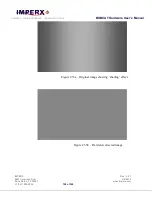
CAMERAS FRAME GRABBERS IMAGING SOLUTIONS
BOBCAT Hardware User’s Manual
IMPERX
Rev. 2.0.7
6421 Congress Ave.
4/8/2014
Boca Raton, FL 33487
www.imperx.com
+1 (561) 989-0006
208 of 329
4.2.3 Camera Serial Protocol
In order to access the camera registers and resources a sequence of bytes needs to be
transmitted to the camera via the Camera Link serial interface. This is an RS232,
asynchronous, full-duplex, serial protocol, with 1 start bit, 8 data bits, 1 stop bit, no hand
shake, and no parity – Figure 3.1. The default baud rate is configurable (9600, 19200,
38400, 57600 and 115200 – default).
Figure 4.1 – Serial protocol format
Each camera control register can be updated independently. In terms of the serial protocol,
all registers are defined as 16-bit address (hex format), and 32-bit data (hex format).
Camera registers using less than 32-bits in width must be padded with ‘0’s on writes, and
unused bits are ignored on reads. Register data is always “packed low” within 32-bit data
words for registers defined less than 32-bits.
There is a latency delay for each command due to command execution and data
transmission over the serial port. This latency varies from command to command because
of resource location and command response length.
4.2.3.1
Write Operation
In order to write to any given camera register, a sequence of 7 bytes should be sent to
the camera. If there is no error the camera returns one byte acknowledge for the write
command <Ack> - Figure 3.2. If there is an error the camera returns two bytes not-
acknowledge for the write command – the first byte is <Nac> <Err>, the second is the
error code – Figure 3.3a,b:
Write to camera (7 Bytes): <Write_Cmd> <
Address
> <
Data
>
1
st
byte: 0x57 (Write Command)
2
nd
byte:
<
Register Address_High
> MSB
3
rd
byte:
<
Register Address_Low
> LSB
4
th
byte:
<
Register Data Byte 4
> MSB
5
th
byte:
<
Register Data Byte 3
> …
6
th
byte:
<
Register Data Byte 2
> …
7
th
byte:
<
Register Data Byte 1
> LSB






























